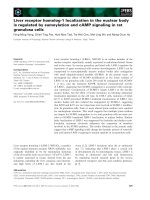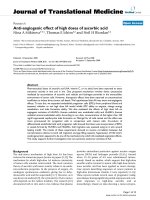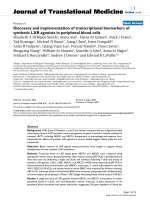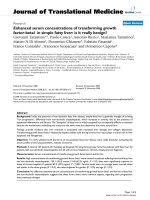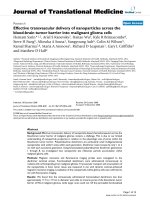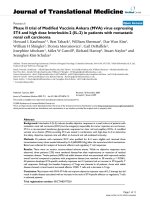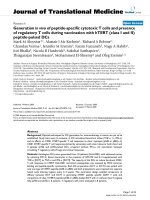báo cáo hóa học: " Lipopolysaccharide-enhanced transcellular transport of HIV-1 across the blood-brain barrier is mediated by luminal microvessel IL-6 and GM-CSF" potx
Bạn đang xem bản rút gọn của tài liệu. Xem và tải ngay bản đầy đủ của tài liệu tại đây (1.25 MB, 37 trang )
This Provisional PDF corresponds to the article as it appeared upon acceptance. Fully formatted
PDF and full text (HTML) versions will be made available soon.
Lipopolysaccharide-enhanced transcellular transport of HIV-1 across the
blood-brain barrier is mediated by luminal microvessel IL-6 and GM-CSF
Journal of Neuroinflammation 2011, 8:167 doi:10.1186/1742-2094-8-167
Shinya Dohgu ()
Melissa A Fleegal-DeMotta ()
William A Banks ()
ISSN 1742-2094
Article type Research
Submission date 18 August 2011
Acceptance date 30 November 2011
Publication date 30 November 2011
Article URL />This peer-reviewed article was published immediately upon acceptance. It can be downloaded,
printed and distributed freely for any purposes (see copyright notice below).
Articles in JNI are listed in PubMed and archived at PubMed Central.
For information about publishing your research in JNI or any BioMed Central journal, go to
/>For information about other BioMed Central publications go to
/>Journal of Neuroinflammation
© 2011 Dohgu et al. ; licensee BioMed Central Ltd.
This is an open access article distributed under the terms of the Creative Commons Attribution License ( />which permits unrestricted use, distribution, and reproduction in any medium, provided the original work is properly cited.
1
Lipopolysaccharide-enhanced transcellular transport of HIV-1 across the blood-
brain barrier is mediated by luminal microvessel IL-6 and GM-CSF
Shinya Dohgu
1,2,3
, Melissa A. Fleegal-DeMotta
2,3,4
, William A. Banks
2,3,5,6
*
1
Department of Pharmaceutical Care and Health Sciences, Faculty of Pharmaceutical
Sciences, Fukuoka University, Fukuoka, Japan
2
Geriatric Research Educational and Clinical Center-St. Louis, St. Louis, MO, USA
3
Division of Geriatric Medicine, Department of Internal Medicine, Saint Louis University
School of Medicine, St. Louis, MO, USA
4
Biology Department, Clarke University, Dubuque, IA, USA
5
Geriatric Research Educational and Clinical Center-Veterans Affairs Puget Sound
Health Care System, Seattle, WA, USA
6
Division of Gerontology and Geriatric Medicine, Department of Internal Medicine,
University of Washington, Seattle, WA, USA
*Corresponding author
William A. Banks, M.D.
Rm 810A/Bldg 1
Geriatric Research Education and Clinical Center, Veterans Affairs Puget Sound Health
Care System
1660 S. Columbian Way, WA 68108, USA
Phone: +1-206-764 2701, Fax: +1-206-764-2569, E-mail:
2
Abstract
Elevated levels of cytokines/chemokines contribute to increased neuroinvasion of human
immunodeficiency virus type 1 (HIV-1). Previous work showed that lipopolysaccharide
(LPS), which is present in the plasma of patients with HIV-1, enhanced transcellular
transport of HIV-1 across the blood-brain barrier (BBB) through the activation of p38
mitogen-activated protein kinase (MAPK) signaling in brain microvascular endothelial
cells (BMECs). Here, we found that LPS (100 µg/mL, 4 hr) selectively increased
interleukin (IL)-6 and granulocyte-macrophage colony-stimulating factor (GM-CSF)
release from BMECs. The enhancement of HIV-1 transport induced by luminal LPS was
neutralized by treatment with luminal, but not with abluminal, antibodies to IL-6 and
GM-CSF without affecting paracellular permeability as measured by transendothelial
electrical resistance (TEER). Luminal, but not abluminal, IL-6 or GM-CSF also increased
HIV-1 transport. U0126 (MAPK kinase (MEK)1/2 inhibitor) and SB203580 (p38 MAPK
inhibitor) decreased the LPS-enhanced release of IL-6 and GM-CSF. These results show
that p44/42 and p38 MAPK signaling pathways mediate the LPS-enhanced release of IL-
6 and GM-CSF. These cytokines, in turn, act at the luminal surface of the BMEC to
enhance the transcellular transport of HIV-1 independently of actions on paracellular
permeability.
Keywords: Blood-brain barrier; Human immunodeficiency virus type 1;
Lipopolysaccharide; Interleukin-6; Granulocyte-macrophage colony-stimulating factor;
Mitogen-activated protein kinase
3
Background
Human immunodeficiency virus type 1 (HIV-1) infection induces
neurological dysfunctions known as the AIDS-dementia complex or HIV-associated
dementia (HAD). Although highly active antiretroviral therapy (HAART) and
combination antiretroviral therapy (cART) have dramatically decreased the incidence and
severity of HAD, the prevalence of HAD, including minor cognitive and motor disorders,
is increasing with the longer lifespan of HIV patients [1]. Most antiretroviral drugs
comprising HAART have a restricted entry into the brain because of blood-brain barrier
(BBB) efflux transporters so that the brain serves as a reservoir for HIV-1 [2] and a
source for viral escape [3]. Therefore, HIV-1 in the brain can contribute to the incidence
and development of HIV-associated neurological impairment in HIV-1 patients both prior
to and after treatment with HAART/cART.
HIV-1 can enter the brain by two routes: the passage of cell-free virus by an
adsorptive endocytosis-like mechanism [4-7] and trafficking of HIV-1-infected immune
cells across the BBB [8]. HIV-1 infection of brain endothelial cells (BECs) is not a
productive infection [9] and penetration of HIV-1 is independent of the CD4 receptor
[10]. At the early stage, HIV-1 enters the brain through an intact, normally functioning
BBB [11]. At later stages of infection, elevated levels of proinflammatory
cytokines/chemokines in the blood of patients with AIDS [12-14] are likely associated
with the increase in HIV-1 infiltration [15-17], while HIV-1 gp120 and Tat induce the
disruption of tight junctions in BECs [17-20].
As reported by Brenchley et al. and confirmed by others, plasma levels of
lipopolysaccharide (LPS), a Gram-negative bacterial endotoxin, are higher in chronic
4
HIV-infected patients with HAART than in the uninfected [3, 21]. Bacterial infection in
HIV patients influences the severity and rate of disease progression [22]. Peripheral LPS
induces various inflammatory and immunological reactions including the production of
cytokines/chemokines, such as tumor necrosis factor-α (TNF-α), interleukin (IL)-1, and
IL-6 [23-25]. TNF-α enhances HIV-1 transport across the BBB [15] and LPS induces an
increase in HIV-1-infected monocyte transport across the BBB [8]. In our previous in
vivo study, we found that the peripheral injection of LPS enhanced gp120 uptake by
brain [26]. These studies suggest that elevated levels of inflammatory mediators,
including cytokines/chemokines and LPS, regulate the permeability of the BBB to HIV-1.
BECs express LPS receptors, such as Toll-like receptor (TLR)-2, TLR-4, and CD14 [27]
and are targets of LPS. The barrier function of the BBB is affected by various
cytokines/chemokines in the blood compartment [28]. Several studies using in vitro BBB
models have shown that LPS increases the paracellular permeability of the BBB [29-33].
LPS induces or enhances the secretion of several cytokines by BECs [34]. Thus, bacterial
infection and the accompanying inflammatory state could be involved in the
enhancement of HIV-1 entry into the brain.
We recently reported that LPS increased transcellular transport of HIV-1
across the BBB through p38 mitogen-activated protein kinase (MAPK) [35]. Here, we
examined whether LPS-enhanced release of cytokines by BMECs mediated the
transcellular transport of HIV-1 and was regulated by MAPK signaling pathways.
5
Materials and Methods
Radioactive labeling
HIV-1 (MN) CL4/CEMX174 (T1) prepared and rendered noninfective by aldrithiol-2
treatment as previously described [36] was a kind gift of the National Cancer Institute,
NIH. The virus was radioactively labeled by the chloramine-T method, a method which
preserves vial coat glycoprotein activity [37, 38]. Two mCi of
131
I-Na (Perkin Elmer,
Boston, MA), 10 µg of chloramine-T (Sigma) and 5.0 µg of the virus were incubated
together for 60 sec. The radioactively labeled virus was purified on a column of
Sephadex G-10 (Sigma).
Primary culture of mouse brain microvascular endothelial cells (BMECs)
BMECs were isolated by a modified method of Szabó et al. [39] and Nakagawa et al.
[38]. The animals
were housed in clean cages in the laboratory with free access
to food
and water and were maintained on a 12-h dark, 12-h light cycle in a room with controlled
temperature (24 ± 1 °C) and humidity (55 ± 5%).
All procedures involving experimental
animals were
approved by the local Animal Care and Use Committee and were
performed
in a facility approved by Association for Assessment
and Accreditation of Laboratory
Animal Care. Cerebral cortices harvested from 8-week-old male CD-1 mice from our in-
house colony were homogenized, BMECs extracted, and cultured as previously
performed [40]. Cultures were treated with puromycin to remove pericytes.
Preparation of in vitro BBB models
BMECs (4 × 10
4
cells/well) were seeded on the inside of the fibronectin-collagen
6
IV (0.1 and 0.5 mg/mL, respectively)-coated polyester membrane (0.33 cm
2
, 0.4 µm pore
size) of a Transwell
®
-Clear insert (Costar, Corning, NY) placed in the well of a 24-well
culture plate (Costar). Culture methods were the same as previously reported [35].
Transendothelial electrical resistance (TEER in Ω × cm
2
) was measured before the
experiments and after an exposure of LPS using an EVOM voltohmmeter equipped with
STX-2 electrode (World Precision Instruments, Sarasota, FL). The TEER of cell-free
Transwell
®
-Clear inserts were subtracted from the obtained values.
Pretreatment protocol
Lipopolysaccharide from Salmonella typhimurium (LPS; Sigma), monoclonal anti-
mouse GM-CSF antibody, anti-mouse IL-6 antibody, mouse GM-CSF, and mouse IL-6
(all purchased from R&D systems, Minneapolis, MN) were dissolved in serum-free
DMEM/F-12 (DMEM/F-12 containing 1 ng/mL bFGF and 500 nM hydrocortisone). The
dose of LPS used in previous BMEC studies (100 µg/mL) was added to the luminal
chamber of the Transwell
®
inserts, and anti-mouse GM-CSF antibody (10 µg/mL), anti-
mouse IL-6 antibody (10 µg/mL), mouse GM-CSF (1-100 ng/mL), or mouse IL-6 (1-100
ng/mL) was loaded into the luminal or abluminal chamber. Then, the BMEC monolayers
were incubated for 4 hr at 37°C with a humidified atmosphere of 5% CO
2
/95% air. In the
experiments using antibodies, rat IgG (Sigma) was added to the control and LPS-treated
group (10 µg/mL as final concentration).
U0126 (MEK inhibitor; Tocris Cookson Inc., Ellisville, MO), SB203850 (p38 MAPK
inhibitor; Tocris) and SP600125 (Jun kinase (JNK) inhibitor; Sigma) were first dissolved
7
in dimethyl sulfoxide (DMSO) and diluted with serum-free DMEM/F-12 (0.1% as the
final DMSO concentration).
Transendothelial transport of
131
I-HIV-1
For the transport experiments, the medium was removed and BMECs were washed
with physiological buffer containing 1% BSA (141 mM NaCl, 4.0 mM KCl, 2.8 mM
CaCl
2
, 1.0 mM MgSO
4
, 1.0 mM NaH
2
PO
4
, 10 mM HEPES, 10 mM D-glucose and 1%
BSA, pH 7.4). The physiological buffer containing 1% BSA was added to the outside
(abluminal chamber; 0.6 mL) of the Transwell
®
insert. To initiate the transport
experiments,
131
I-HIV-1 (3 × 10
6
cpm/mL) was loaded on the luminal chamber. The side
opposite to that to which the radioactive materials were loaded is the collecting chamber.
Samples (0.5 ml) were removed from the abluminal chamber at 15, 30, 60 and 90 min
and immediately replaced with an equal volume of fresh 1% BSA/physiological buffer.
All samples were mixed with 30% trichloroacetic acid (TCA; final concentration 15%)
and centrifuged at 5,400 ×g for 15 min at 4°C. Radioactivity in the TCA precipitate was
determined in a gamma counter. The permeability coefficient and clearance of TCA-
precipitable
131
I-HIV-1 was calculated according to the method described by Dehouck et
al. [41]. Clearance was expressed as microliters (µL) of radioactive tracer diffusing from
the luminal to abluminal (influx) chamber and was calculated from the initial level of
radioactivity in the loading chamber and final level of radioactivity in the collecting
chamber:
Clearance (µL) = [C]
C
× V
C
/ [C]
L
,
where [C]
L
is the initial radioactivity in a microliter of loading chamber (in cpm/µL),
8
[C]
C
is the radioactivity in a microliter of collecting chamber (in cpm/µL), and V
C
is the
volume of collecting chamber (in µL). During a 90-min period of the experiment, the
clearance volume increased linearly with time. The volume cleared was plotted versus
time, and the slope was estimated by linear regression analysis. The slope of clearance
curves for the BMEC monolayer plus Transwell
®
membrane was denoted by PS
app
, where
PS is the permeability × surface area product (in µL/min). The slope of the clearance
curve with a Transwell
®
membrane without BMECs was denoted by PS
membrane
. The real
PS value for the BMEC monolayer (PS
e
) was calculated from
1 / PS
app
= 1 / PS
membrane
+ 1 / PS
e
.
The PS
e
values were divided by the surface area of the Transwell
®
inserts (0.33 cm
2
) to
generate the endothelial permeability coefficient (P
e
, in cm/min).
Cytokine detection
BMECs (4 × 10
4
cells/well) were seeded on the fibronectin/collagen I/collagen IV
(0.05, 0.05, and 0.1 mg/mL, respectively)-coated 24-well culture plate (Costar). BMECs
were washed with serum-free DMEM/F-12, and then exposed to 200 µL of LPS
(100µg/mL) with or without U0126 (10 µM), SB203580 (10 µM), and SP600125 (10
µM) for 4 hr at 37°C. Culture supernatant was collected and stored at -80°C until use.
The cytokines (GM-CSF, IFN-γ, IL-1α, IL-1β, IL-2, IL-4, IL-6, IL-10, IL-12 (p70), and
TNF-α) were measured with the mouse cytokine/chemokine Lincoplex
®
kit (Linco
Research, St. Charles, MO) by following the manufacturer’s instructions.
9
Western blot analysis
LPS, GM-CSF, or IL-6-treated and control BMECs were washed three times with ice-
cold phosphate buffered saline containing 1 mM sodium orthovanadate (Na
3
VO
4
) and 1
mM sodium fluoride (NaF). Cells were scraped and lysed in phosphoprotein lysis buffer
(10 mM Tris-HCl, pH 6.8, 100 mM NaCl, 1 mM EDTA, 1 mM EGTA, 10% glycerol, 1%
Triton X-100, 0.1% SDS, 0.5% sodium deoxycholate, 20 mM sodium pyrophosphate
decahydrate, 2 mM Na
3
VO
4
, 1 mM NaF, 1 mM phenylmethylsulfonyl fluoride)
containing 1% protease inhibitor cocktail (Sigma) on ice. Cell lysates were centrifuged
(15,000 ×g at 4°C for 15 min) and the supernatants were stored at -80°C until use. The
protein concentration of each sample was determined using a BCA protein assay kit
(Pierce, Rockford, IL). Twenty to thirty µg of the total protein was mixed with
NuPAGE
®
LDS sample buffer (Invitrogen) and incubated for 3 min at 100°C. Proteins
were separated on NuPAGE
®
Novex 4-12% Bis-Tris gel (Invitrogen) and then transferred
to a polyvinylidene difluoride (PVDF) membrane (Invitrogen). After transfer, the blots
were blocked with 5% BSA/Tris-buffered saline (TBS: 20 mM Tris-HCl, pH 7.5, 150
mM NaCl) containing 0.05% Tween 20 (TBS-T) for 1 hr at room temperature. The
membrane was incubated with the primary antibody diluted in 5% BSA/TBS-T overnight
at 4°C. The phosphorylation of p44/42 MAPK, p38 MAPK and JNK were detected using
anti-phospho-p44/42 MAPK (1:1000), anti-phospho-p38 MAPK (1:500) and anti-
phospho-JNK (1:500) rabbit monoclonal antibodies, respectively (all purchased from Cell
Signaling Technology, Beverly, MA). Occludin, claudin-5, and ZO-1 were detected using
anti-occludin, anti-claudin-5, and anti-ZO-1 mouse monoclonal antibodies (all purchased
from Zymed, South San Francisco, CA). Blots were washed and incubated with
10
horseradish peroxidase-conjugated anti-mouse IgG or anti-rabbit IgG (1:10,000; Santa
Cruz Biotechnology, Santa Cruz, CA) diluted in 5% BSA/TBS-T for 1 hr at room
temperature. The immunoreactive bands were visualized on an X-ray film (Kodak) using
SuperSignal
®
West Pico chemiluminescent substrate kit (Pierce). To reprobe total p44/42
MAPK, p38 MAPK, JNK, and actin, the membrane was incubated in stripping buffer (0.2
M glycine, 0.1% SDS and 1% Tween 20, pH 2.2) for 15 min twice and blocked with 5%
non-fat dry milk/TBS-T. The total p44/42 MAPK, p38 MAPK and JNK were detected
using anti-p44/42 MAPK (1:1000), p38 MAPK (1:1000), JNK (1:1000) (all purchased
from Cell Signaling Technology), and actin (1:1000; Santa Cruz Biotechnology)
antibodies, respectively. To quantify the relative levels of protein expression, the
intensity of specific protein bands was quantified using ImageJ software (National
Institute of Health, Bethesda, MD) and then normalized by that of each loading control
protein.
Statistical analysis
Values are expressed as means ± SEM. One-way and two-way analysis of variances
(ANOVAs) followed by Dunnett’s or Tukey-Kramer’s test were applied to multiple
comparisons. Paired t-test was applied to the densitometry analysis. The differences
between means were considered to be significant when P values were less than 0.05
using Prism 5.0 (GraphPad, San Diego, CA).
11
Results
LPS stimulated release of GM-CSF and IL-6 by BMEC
As shown in Table 1, BMECs spontaneously secreted IL-1β, IL-2, IL-4, IL-10, IL-12,
and TNF-α in the 0.5-2.5 pg/mL range, and GM-CSF, IFN-γ, and IL-6 in 4-7 pg/mL
range in this study. The concentration of IL-1α was below the detection level of the assay.
A 4 hr exposure of BMECs to LPS (100 µg/mL) significantly induced 33- and 2.4-fold
increases in the levels of GM-CSF and IL-6, respectively (P < 0.01). LPS significantly
decreased the secretion of IFN-γ by BMECs (P < 0.01), but the decrease in the secretion
of IL-12 with LPS did not reach statistical significance. Secretion of IL-1β, IL-2, and IL-
10 was not detected after LPS treatment. The level of IL-4 and TNF-α did not change
after LPS treatment.
Polarized effect of antibodies to IL-6 and GM-CSF on LPS-induced increase in HIV-1
permeability and paracellular permeability of BMEC monolayer
To examine whether the enhanced release of IL-6 and GM-CSF induced by LPS
was involved in the LPS-induced increases in HIV-1 permeability and paracellular
permeability of the BMEC monolayer, we exposed BMEC monolayers to LPS with
antibodies to IL-6 and GM-CSF. Since BMECs can release cytokines from either their
luminal or abluminal surface [34], we examined the functional polarity of antibodies to
IL-6 and GM-CSF by adding them into the luminal or abluminal chambers. We assessed
the paracellular permeability of the BMEC monolayer by measuring TEER. LPS (100
µg/mL for 4 hr) added to the luminal chamber significantly increased
131
I-HIV-1
permeability of BMEC monolayers (Fig. 1A and 1C) and decreased TEER (Fig. 1B and
12
1D). The presence of antibodies to IL-6 and GM-CSF (10 µg/mL, respectively) in the
luminal chamber significantly attenuated the LPS-induced increase in
131
I-HIV-1 (Fig.
1A), but not the LPS-induced decrease in TEER (Fig. 1B). In contrast, antibodies added
into the abluminal chamber did not inhibit the LPS-induced increase in
131
I-HIV-1
permeability and the decrease in TEER (Fig. 1C and D).
Polarized response to IL-6 and GM-CSF in the permeability of BMEC monolayer
To determine whether IL-6 and GM-CSF mediate HIV-1 transport across the
BBB and decrease TEER with the functional polarity, BMECs were treated with various
concentrations of mouse IL-6 and GM-CSF (1-100 ng/mL, respectively) in the luminal or
abluminal chamber. In Fig. 2A, luminal treatment with IL-6 (1, 10, and 100 ng/mL)
increased HIV-1 transport to 104.6 ± 6.8, 121.9 ± 5.4, and 127.9 ± 4.1 % of control, but
abluminal treatment did not induce significant changes in HIV-1 transport (96.5 ± 3.2,
110.2 ± 3.6, and 99.6 ± 5.0 % of control). Luminal treatment with IL-6 (1, 10, and 100
ng/mL) significantly decreased TEER (Fig. 2B) from 72.1 ± 1.2 to 64.2 ± 2.8, 58.3 ± 2.0,
and 56.4 ± 1.4 Ω × cm
2
. Abluminal treatment with IL-6 significantly decreased TEER
from 72.0 ± 2.0 to 58.9 ± 2.7 Ω × cm
2
at the concentration of 100 ng/mL. For the
permeability to HIV-1 (Fig. 2A), a two-way ANOVA showed significant effects for the
factors “loading chamber” (luminal or abluminal) [F(1, 67) = 11.42, P < 0.01],
concentration [F(3, 67) = 5.715, P < 0.01], and interaction (loading chamber ×
concentration) [F(3, 67) = 2.788, P < 0.05]. For TEER (Fig. 2B), a two-way ANOVA
showed a significant effect for concentration [F(3, 58) = 10.08, P < 0.001], but not for
loading chamber and interaction.
13
As shown in Fig. 3A, GM-CSF (1, 10, 100 ng/mL) in the luminal chamber
increased HIV-1 transport to 103.6 ± 3.4, 107.0 ± 5.4, and 124.0 ± 5.1 % of control, but
GM-CSF in the abluminal chamber did not (101.8 ± 5.1, 94.5 ± 3.9, and 95.4 ± 5.2 % of
control). Neither the luminal nor abluminal treatments with GM-CSF changed TEER (Fig.
3B). For the permeability to HIV-1 (Fig. 3A), a two-way ANOVA showed significant
effects for loading chamber [F(1, 44) = 7.746, P < 0.01] and interaction [F(3, 44) = 2.909,
P < 0.01] but not concentration. For TEER (Fig. 3B), a two-way ANOVA showed a
significant effect for loading chamber [F(1, 74) = 4.682, P < 0.05] but not concentration
or interaction.
These results indicated that the effects of LPS on BMECs permeability to HIV-1
were mainly mediated by IL-6 and GM-CSF acting at the luminal surface of the BMEC.
In all subsequent studies, therefore, we employed the luminal chamber as the loading
chamber.
Effects of LPS, IL-6, and GM-CSF on the expression of tight junction proteins
To examine the effects of LPS, IL-6, and GM-CSF on the expression of tight
junction proteins, BMECs were exposed to LPS (100µg/mL), IL-6 (100 ng/mL), and
GM-CSF (100 ng/mL) for 4 hr (Fig. 4). The densitometry analysis showed that there
were no significant changes in the expression of tight junction proteins induced by LPS,
IL-6, and GM-CSF.
Effect of MAPK inhibitors on the release of IL-6 and GM-CSF enhanced by LPS
14
We previously demonstrated that LPS activated p44/42 MAPK and p38 MAPK
pathways in BMECs [35]. To test whether LPS enhances the release of IL-6 and GM-
CSF by BMECs through MAPK signaling pathways, BMECs were exposed to LPS with
various MAPK inhibitors (U0126, SB203580, and SP600125) for 4 hr. As shown in Fig.
5A and 5B, LPS significantly enhanced the release of IL-6 and GM-CSF by BMECs
from 1.7 ± 0.71 to 35.5 ± 10.5 pg/mL (P < 0.01) and from 7.8 ± 7.8 to 261.4 ± 25.7
pg/mL (P < 0.001), respectively. In the presence of 10 µM of U0126 (MEK1/2 inhibitor),
the LPS-induced increase in the release of IL-6 and GM-CSF by BMECs was
significantly decreased to 13.0 ± 2.1 (P < 0.05 vs LPS) and 199.0 ± 16.0 pg/mL (P < 0.05
vs LPS), respectively. Similarly, SB203580 (10 µM: p38 MAPK inhibitor) significantly
decreased the LPS-enhanced release of IL-6 and GM-CSF by BMECs to 14.9 ± 3.1 (P <
0.05 vs LPS) and 139.9 ± 10.8 pg/mL (P < 0.01 vs LPS). The JNK inhibitor SP600125
(10 µM) did not affect the LPS-enhanced release of IL-6 and GM-CSF.
Effects of IL-6 and GM-CSF on phosphorylation of p44/42 MAPK, p38, and JNK
To determine whether IL-6 and GM-CSF could activate MAPK pathways in
BMECs as in the case of LPS phosphorylation of MAPKs were measured by western blot
analysis (Fig. 6). A 4 hr exposure of BMECs to IL-6 (100 ng/mL) or GM-CSF (100
ng/mL) in the luminal side did not increase the phosphorylation of p44/42 MAPK, p38,
or JNK.
15
Discussion
The present study evaluated whether the LPS-enhanced transcellular transport of
HIV-1 across BMEC monolayers was mediated through the induction of the release of
cytokines from BMECs. Our main findings are summarized in figure 7. BMECs
spontaneously secreted GM-CSF, IFN-γ, IL-2, IL-4, IL-6, and TNF-α (Table 1) with
relatively high concentrations (> 4 pg/mL) of IL-6, GM-CSF, and IFN-γ. LPS markedly
increased the concentrations of IL-6 and GM-CSF. Therefore, we hypothesized that IL-6
and/or GM-CSF might mediate the LPS-induced increase in HIV-1 transport across the
BBB. Previously, we showed that BMECs in which pericytes were not removed
spontaneously secrete GM-CSF, IL-1α, IL-6, IL-10, and TNF-α and that LPS stimulates
the secretion of GM-CSF, IL-6, IL-10, and TNF-α [34]. In the current study, the LPS-
induced increase in IL-10 and TNF-α secretion was not observed. This may be attributed
to the differences of culture conditions, such as the use of culture medium containing
hydrocortisone, absence of pericytes, or differences among batches of LPS. Although
hydrocortisone inhibits the production of TNF-α by LPS-stimulated monocytes [42], the
concentration of hydrocortisone that we used was at a physiological level [43].
BBB disruption can occur either [44] through the paracellular route (increased
leakage between cells as measured by a decrease in TEER) or though the transcellular
route (increased passage across a cell). Viral-sized particles [45], including HIV-1 [7],
generally cross by the transcellular route. Our previous work found that LPS both
increased the transcellular permeability of the BMEC monolayer to HIV-1 and decreased
TEER [35]. Here, we examined whether IL-6 and GM-CSF release from BMEC by LPS
mediated these effects. The presence of LPS and antibodies to IL-6 or GM-CSF in the
16
luminal chamber attenuated LPS-enhanced HIV-1 transport across the BMEC monolayer
without a change in TEER (Fig. 1A and 1B). BMECs secrete IL-6 and GM-CSF into both
the luminal and abluminal chambers [34]. To determine whether IL-6 and GM-CSF
secreted by BMECs into the abluminal chamber are also involved in the LPS-induced
increase in HIV-1 transport, we added antibodies to IL-6 or GM-CSF to the abluminal
chamber. Neither antibody in the abluminal chamber inhibited the luminal LPS-induced
changes in HIV-1 transport and TEER (Fig. 1C and 1D). These results show that the IL-6
and GM-CSF secreted by BMECs in response to luminal exposure to LPS act at the
luminal, but not the abluminal, endothelial surface to increase the transcellular
permeability of BMECs to HIV-1. Furthermore, the results suggest that the LPS-induced
increase in the paracellular permeability of the BMEC monolayer as measured by TEER
is not mediated by extracellular IL-6 and GM-CSF.
We further investigated this functional polarity by adding IL-6 and GM-CSF to
the luminal or abluminal chamber. Polarity of other cytokine actions has been
investigated. We previously found that BMECs show no functional polarity in the
reduction of paracellular permeability by transforming growth factor (TGF)-β1 [46]. That
is, either luminal or abluminal TGF-β1 has the same effect on the BBB paracellular
permeability. In contrast, MCP-1 is only able to stimulate monocyte migration across
BMECs when added to the abluminal surface [47]. In the current study, only luminal IL-6
increased HIV-1 transport and was 10-100 fold more potent than abluminal IL-6 in
decreasing TEER (Fig. 2). Consistent with this, de Vries et al. reported that IL-6
increased paracellular permeability of BMECs [48]. However, we found here that the IL-
6-induced decrease in TEER was less than the LPS-induced decrease in TEER. Other
17
soluble factors, such as other cytokines or chemokines, may be responsible for the
remaining increase in the paracellular permeability induced by LPS. An IL-6-independent,
P44/42-mediated phosphorylation of tight junction proteins may also be operational. The
ability of IL-6 to decrease TEER but an inability of IL-6 antibody to block the effect of
LPS on TEER suggests either that the LPS effect is not mediated through IL-6 or that IL-
6 acts at a site not available to antibodies, such as inside the cell. Abluminal IL-6 (100
ng/mL) did not alter HIV-1 permeability despite the decrease in TEER. This finding is
consistent with IL-6 promoting a transcellular or transcytotic mechanism for HIV-1
passage across the BBB that is independent of the paracellular pathway.
Luminal GM-CSF at the concentration of 100 ng/mL increased HIV-1 transport,
whereas abluminal GM-CSF did not. Neither luminal nor abluminal GM-CSF changed
TEER (Fig. 3). This result further supports the idea that HIV-1 penetration across the
BBB is through the transcellular route rather than the paracellular route. In addition, these
results may suggest that the receptors for IL-6 and GM-CSF that affect HIV-1
permeability are mainly localized to the luminal membrane of BMECs. Therefore,
enhanced invasion of HIV-1 into the brain may be mediated by BMEC-derived cytokines
secreted into blood or by blood-borne cytokines. Consistent with this, IL-6 in the blood
compartment induces BBB dysfunction [48, 49]. As summarized above, LPS, IL-6, and
GM-CSF altered both HIV-1 permeability and TEER. The disparities discussed above
between these two parameters of BBB function make it likely that they are separate
events. Whereas the increased permeability to HIV-1 is likely mediated through
transcytotic mechanisms, the decrease in TEER is caused by increased paracellular
permeability resulting from altered tight junction function. LPS is known to alter the
18
intensity and pattern of immunohistochemistry for the tight junction proteins claudin-5,
ZO-1, and F-actin in BMECs [31, 33]. We examined whether LPS, IL-6, and GM-CSF
affected the expression of these tight junction proteins in our models (Fig. 4). The
luminal treatment with LPS, IL-6, or GM-CSF did not induce significant changes in the
expression of tight junction proteins in BMECs. Therefore, under the conditions of our
model, LPS and IL-6 are likely increasing paracellular permeability of BMECs by
altering tight junction function rather than expression of their proteins. For example, LPS
and IL-6 may affect the localization of tight junction proteins in BMECs to increase the
paracellular permeability.
Our previous work showed that LPS activated p44/42 MAPK and p38 MAPK in
BMECs, and the activation of p38 MAPK resulted in the increase in HIV-1 transport [35].
The activation of the p38 MAPK pathway leads to the production and release of
inflammatory cytokines [50]. Considering our present results, we hypothesized that either
(i) LPS induced the production of IL-6 and GM-CSF through MAPKs or (ii) IL-6 and
GM-CSF activated MAPKs. First, we determined whether the LPS-enhanced release of
IL-6 and GM-CSF was mediated by MAPK signaling pathways as shown by the
experiments using U0126 (MEK1/2 inhibitor), SB203580 (p38 MAPK inhibitor), and
SP600125 (JNK inhibitor) (Fig. 5). U0126 and SB203580 inhibited the LPS-enhanced
release of IL-6 and GM-CSF by BMECs. In the SP600125-treated group, inhibitory
effects were not detected. This is reasonable as an LPS-induced increase in the
phosphorylation of JNK has not been detected [35]. These results indicated that LPS
enhanced the release of IL-6 and GM-CSF from BMECs through the phosphorylation of
p44/42 MAPK and p38 MAPK. Thus, the transcellular pathway taken by free virus
19
differs from the JNK dependent, CD40-mediated pathway used by infected monocytes to
cross the BBB [3].
Next, we determined whether IL-6 and GM-CSF increased the phosphorylation of
MAPKs. IL-6 and GM-CSF did not increase the phosphorylation of p44/42 MAPK, p38
MAPK, or JNK (Fig. 6). These results indicated that the IL-6- and GM-CSF-induced
changes in the BMEC permeability for HIV-1 and paracellular permeability are
downstream of the MAPK signaling pathways. Pathways downstream of the cytokines
are likely COX-2 for IL-6-induced changes in TEER [48] and the JAK/STAT pathway
for IL-6 and GM-CSF [51, 52] mediation of HIV-1 effects on immune cell migration [53].
Thus, IL-6 and GM-CSF likely increase HIV-1 transport across the BBB through other
intracellular signaling pathways. As for the mechanisms by which LPS could increase
HIV-1 transport across the BBB, the following sequential events are proposed: (1) LPS
activates p44/42 MAPK and p38 MAPK in BMECs; (2) this activation induces BMECs
to release IL-6 and GM-CSF into the blood; (3) IL-6 and GM-CSF act at the luminal
surface of the BMECs to enhance the transcellular transport of HIV-1 across the BBB.
In our previous study, we demonstrated that p38 MAPK mediated LPS-enhanced
HIV-1 transport and p44/42 MAPK mediated the LPS-induced increase in paracellular
permeability using each pathway inhibitor [35]. U0126, the p44/42 MAPK inhibitor, did
not attenuate LPS-enhanced HIV-1 transport. Here, U0126 as well as SB203580
decreased the release of IL-6 and GM-CSF (Fig. 5). These findings suggest that the p38
MAPK signaling pathway directly leads to enhanced LPS-mediated transcellular
transport of HIV-1.
20
In conclusion, we found that LPS potentiated the release of IL-6 and GM-CSF by
BMECs through the activation of p44/42 MAPK and p38 MAPK. In addition to the p38
MAPK pathway, IL-6 and GM-CSF released from BECs acted at the luminal but not the
abluminal surface to enhance HIV-1 transcellular transport. The p44/42 MAPK pathway
and IL-6 likely acted at an intracellular site to increase paracellular permeability. Thus,
LPS effects on HIV-permeation and on paracellular permeability were mediated through
different cellular pathways. These results suggest that the release of cytokines by BECs
plays an important role in the invasion of HIV-1 into the central nervous system.
Preventing cytokine release by BECs through MAPK signaling pathways may be a
therapeutic target in HIV-associated neurological dysfunction.
Abbreviations
ANOVA: Analysis of variance; BBB: Blood-brain barrier; BEC: Brain endothelial cells;
BMEC: Brain microvascular endothelial cells; cART: Combination antiretroviral
therapy; GM-CSF: Granulocyte-macrophage colony-stimulating factor; HAART: Highly
active antiretroviral therapy; HAD: HIV-1-associated dementia; HIV-1: Human
immunodeficiency virus type 1; IL: Interleukin; IFN: Interferon; JNK: Jun kinase; LPS:
Lipopolysaccharide; MAPK: Mitogen-activated protein kinase; MEK: MAPK kinase; P
e
:
Permeability coefficient; PVDF: Polyvinylidene difluoride; TEER: Transendothelial
electrical resistance; TGF: Transforming growth factor; TLR: Toll-like receptor; TNF-α:
Tumor necrosis factor-α
21
Competing interests
The authors have no conflicts or competing interests.
Authors’ contributions
All authors contributed to experimental design in an interactive and synergistic fashion.
Experiments were performed by SD and MAF-D. Writing was a joint effort with WAB
overseeing and editing final draft. All authors have read and validated the final
manuscript.
Acknowledgements
The authors thank Dr. Maria A. Deli (Institute of Biophysics, Biological Research Centre
of the Hungarian Academy of Sciences) for technical advice on primary BMEC culture
and comments on this study. The virus was a kind gift the National Cancer Institute,
National Institutes of Health. Funded in part with Federal funds from National Cancer
Institute, National Institutes of Health, under Contract No. N01-CO-12400. The content
of this publication does not necessarily reflect the views or policies of the Department of
Health and Human Services, nor does mention of names, commercial products, or
organization imply endorsement by the U.S. government. Supported by VA Merit
Review (WAB), NIH R01NS050547 (WAB), and NIH R01AG029839 (WAB).
22
References
1. Gonzalez-Scarano F, Martin-Garcia J: The neuropathogenesis of AIDS. Nature
Rev Immunol 2005, 5:69-81.
2. McArthur JC, Haughey N, Gartner S, Conant K, Pardo C, Nath A, Sacktor N:
Human immunodeficiency virus-associated dementia: An evolving disease. J
Neurovirol 2003, 9:205-221.
3. Eden A, Fuchs D, Hagberg L, Nilsson S, Spudich S, Svennerholm B, Price RW,
Geisslen M: HIV-1 viral escape in cerebrospinal fluid of subjects on
suppressive antiretroviral treatment. Journal of Infectious Diseases 2010,
202:1768-1769.
4. Banks WA, Akerstrom V, Kastin AJ: Adsorptive endocytosis mediates the
passage of HIV-1 across the blood-brain barrier: evidence for a post-
internalization coreceptor. Journal of Cell Science 1998, 111:533-540.
5. Banks WA, Freed EO, Wolf KM, Robinson SM, Franko M, Kumar VB:
Transport of human immunodeficiency virus type 1 pseudoviruses across the
blood-brain barrier: role of envelope proteins and adsorptive endocytosis.
Journal of Virology 2001, 75:4681-4691.
6. Banks WA, Robinson SM, Wolf KM, Bess JW, Jr., Arthur LO: Binding,
internalization, and membrane incorporation of human immunodeficiency
virus-1 at the blood-brain barrier is differentially regulated. Neuroscience
2004, 128:143-153.
7. Nakaoke R, Ryerse JS, Niwa M, Banks WA: Human immunodeficiency virus
type 1 transport across the in vitro mouse brain endothelial cell monolayer.
Experimental Neurology 2005, 193:101-109.
8. Persidsky Y, Stins M, Way D, Witte MH, Weinand M, Kim KS, Bock P,
Gendelman HE, Fiala M: A model for monocyte migration through the blood-
brain barrier during HIV-1 encephalitis. The Journal of Immunology 1997,
158:3499-3510.
9. Liu NQ, Lossinsky AS, Popik W, Li X, Gujuluva C, Kriederman B, Roberts J,
Pushkarsky T, Bukrinsky M, Witte M, et al: Human immunodeficiency virus
type I enters brain microvascular endothelia by macropinocytosis dependent
on lipid rafts and the mitogen-activated protein kinase signaling pathway.
Journal of Virology 2002, 76:6689-6700.
10. Moses AV, Bloom FE, Pauza CD, Nelson JA: Human immunodeficiency virus
infection of human brain capillary endothelial cells occurs via a
CD4/galactosylceramide-independent mechanism. Proceedings of the National
Academy of Sciences USA 1993, 90:10474-10478.
11. Davis LE, Hjelle BL, Miller VE, Palmer DL, Llewellyn AL, Merlin TL, Young
SA, Mills RG, Wachsman W, Wiley CA: Early viral brain invasion in
iatrogenic human immunodeficiency virus infection. Neurology 1992,
42:1736-1739.
12. Alonso K, Pontiggia P, Medenica R, Rizzo R: Cytokine patterns in adults with
AIDS. ImmunolInvest 1997, 26:341-350.
13. Gartner S: HIV infection and dementia. Science 2000, 287:602-604.
23
14. Hittinger G, Poggi C, Delbeke E, Profizi N, Lafeuillade A: Correlation between
plasma levels of cytokines and HIV-1 RNA copy number in HIV-infected
patients. Infection 1998, 26:100-103.
15. Fiala M, Looney DJ, Stins M, Way DD, Zhang L, Gan X, Chiappelli F,
Schweitzer ES, Shapshak P, Weinand M, et al: TNF-alpha opens a paracellular
route for HIV-1 invasion across the blood-brain barrier. Molecular Medicine
1997, 3:553-564.
16. Chaudhuri A, Duan F, Morsey B, Persidsky Y, Kanmogne GD: HIV-1 activates
proinflammatory and interferon-inducible genes in human brain
microvascular endothelial cells: putative mechanisms of blood-brain barrier
dysfunction. J Cereb Blood Flow Metab 2007, 28:697-711.
17. Kanmogne GD, Primeaux C, Grammas P: HIV-1 gp120 proteins alter tight
junction protein expression and brain endothelial cell permability:
implications for the pathogenesis of HIV-associated dementia. Journal of
Neuropathology and Experimental Neurology 2005, 64:498-505.
18. Andras IE, Pu H, Deli MA, Nath A, Hennig B, Toborek M: HIV-1 Tat protein
alters tight junction protein expression and distribution in cultured brain
endothelial cells. Journal of Neuroscience Research 2003, 74:255-265.
19. Pu H, Tian J, Flora G, Lee YW, Nath A, Hennig B, Toborek M: HIV-1 Tat
protein upregulates inflammatory mediators and induces monocyte invasion
into the brain. Molecular and Cellular Neurosciences 2003, 24:224-237.
20. Andras I, Pu H, Tian J, Deli MA, Nath A, Hennig B, Toborek M: Signaling
mechanisms of HIV-1 Tat-induced alterations of claudin-5 expression in
brain endothelial cells. J Cereb Blood Flow Metab 2005, 25:1159-1170.
21. Brenchley JM, Price DA, Schacker TW, Asher TE, Silvestri G, Rao S, Kazzaz Z,
Bornstein E, Lambotte O, Altmann D, et al: Microbial translocation is a cause
of systemic immune activation in chronic HIV injection. Nature Medicine
2006, 12:1365-1371.
22. Blanchard A, Montagnier L, Gougeon ML: Influence of microbial infections on
the progression of HIV disease. Trends Microbiol 1997, 5:326-331.
23. Hesse DG, Tracey KJ, Fong Y, Manogue KR, Palladino MA, Cerami A, Shires
GT, Lowry SF: Cytokine appearance in human endotoxemia and primate
bacteremia. Surg Gynecol Obstet 1998, 166:147-153.
24. Martich GD, Boujoukos AJ, Suffredini AF: Response of man to endotoxin.
Immunobiology 1993, 187:403-416.
25. Shalaby MR, Waage A, Aarden L, Espevik T: Endotoxin, tumor necrosis
factor-alpha and interleukin-1 induce interleukin 6 production in vivo. Clin
Immunol Immunopath 1989, 53:488-498.
26. Banks WA, Kastin AJ, Brennan JM, Vallance KL: Adsorptive endocytosis of
HIV-1gp120 by blood-brain barrier is enhanced by lipopolysaccharide.
Experimental Neurology 1999, 156:165-171.
27. Singh AK, Yiang Y: How does peripheral lipopolysaccharide induce gene
expression in the brain of rats? Toxicology 2004, 201:197-207.
28. Deli MA, Abraham CR, Kataoka Y, Niwa M: Permeability studies on in vitro
blood-brain barrier models: physiology, pathology, and pharmacology.
Cellular and Molecular Neurobiology 2005, 25:59-127.
24
29. Tunkel AR, Rosser SW, Hansen EJ, Scheld WM: Blood-brain barrier
alterations in bacterial meningitis: development of an in vitro model and
observations on the effects of lipopolysaccharide. In Vitro Cellular &
Developmental Biology 1991, 27A:113-120.
30. De Vries HE, Blom-Roosemalen MCM, De Boer AG, van Berkel TJ, Breimer
DD, Kuiper J: Effect of endotoxin on permeability of bovine cerebral
endothelial cell layers in vitro. Journal of Pharmacology and Experimental
Therapeutics 1996, 277:1418-1423.
31. Descamps L, Coisne C, Dehouck B, Cecchelli R, Torpier G: Protective effect of
glial cells against lipopolysaccharide-mediated blood-brain barrier injury.
Glia 2003, 42:46-58.
32. Boveri M, Kinsner A, Berezowski V, Lenfant AM, Draing C, Cecchelli R,
Dehouck MP, Hartung T, Prieto P, Bal-Price A: Highly purified lipoteichoic
acid from gram-p0sitive bacteria induced in vitro blood-brain barrier
disruption through glia activation: role of proinflammatory cytokines and
nitric oxide. Neuroscience 2006, 137:1193-1209.
33. Veszelka S, Pasztoi M, Farkas AE, Krizbai I, Ngo TK, Niwa M, Abraham CS,
Deli MA: Pentosan polysulfate protects brain endothelial cells against
bacterial lipopolysaccharide-induced damages. Nerurochem Int 2007, 50:219-
228.
34. Verma S, Nakaoke R, Dohgu S, Banks WA: Release of cytokines by brain
endothelial cells: a polarized response to lipopolysaccharide. Brain,Behavior,
and Immunity 2006, 20:449-455.
35. Dohgu S, Banks WA: Lipopolysaccharide-enhanced transcellular transport of
HIV-1 across the blood-brain barrier is medited by the p38 mitogen-
activated protein kinase pathway. Experimental Neurology 2008, 210:740-749.
36. Rossio JL, Esser MT, Suryanarayana K, Schneider DK, Bess JW, Jr., Vasquez
GM, Wiltrout TA, Chertova E, Grimes MK, Sattentau Q, et al: Inactivation of
human immunodeficiency virus type 1 infectivity with preservation of
conformational and functional integrity of virion surface proteins. Journal of
Virology 1998, 72:7992-8001.
37. Frost EH: Radioactive labelling of viruses: an iodination preserving biological
properties. JGenVirol 1977, 35:181-185.
38. Montelaro RC, Rueckert RR: On the use of chloramine-T to iodinate
specifically the surface proteins of intact enveloped viruses. JGenVirol 1975,
29:127-131.
39. Szabo CA, Deli MA, Ngo TKD, Joo F: Production of pure primary rat
cerebral endothelial cell culture: a comparison of different methods.
Neurobiology 1997, 5:1-16.
40. Perriere N, Demeuse P, Garcia E, Regina A, Debray M, Andreux JP, Couvreur P,
Scherrmann JM, Temsamani J, Couraud PO, et al: Puromycin-based
purification of rat brain capillary endothelial cell cultures. J Neurochem 2005,
93:279-289.
41. Dehouck MP, Jolliet-Riant P, Bree F, Fruchart JC, Cecchelli R, Tillement JP:
Drug transfer across the blood-brain barrier: Correlation between in vitro
and in vivo models. J Neurochem 1992, 58:1790-1797.
